|
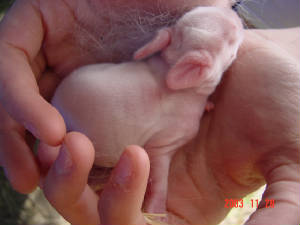
3 Day Old Kit
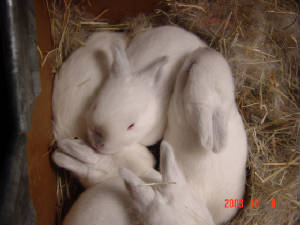
13 Day Old Kits
Breeding/Kindling The female rabbit is called
a Doe and a male rabbit is called a Buck and baby rabbits are called Kits. When you breed the rabbits you Always take the Doe to the Bucks cage never the other way around! The
reason for this is Does are very territorial and the Doe might attack the Buck defending her territory. Rabbits do not
have a heat cycle like other animals do even though some people seem to think there are certain times rabbits are more
receptive then other times but this has not been proven. You can look at the Does vulvu and if it is a dark pink or purple
and moist she will be more receptive at this time if not just check it each day until you find these conditions
and then breed her. The Doe most of the time immediately becomes ready when put with the Buck. Sometimes it might seem
the Doe is fighting the Buck and wants nothing to do with him and runs around circling him, but this performance is just
part of their mating ritual. When she finally stops or he catches her and she lets him mount her and she rises and accepts
the buck he will fall over on one side or backwards after he has been sucessful. About 3 times of this process is best but
if you can only get 1-2 times that could be sufficient enough for her to concieve. Now if you want to ensure the
breed and possiably increase the litter size, you can try to rebreed them 8-12 hours from the first breed but not after 12
hours 10 hours is best to be safe. This is because a rabbit has two horns and can be bred in one horn and if bred
later and is already bred can become pregnant in the second horn and you could loose both Doe and Kits. The Doe is stimulized
by the Buck breeding her and this causes her eggs to decend somewhere around the 8-12 hours after he has bred her so by breeding
them the second round helps to ensure more live sperm are available to fertilize the eggs.
If you have problems getting them to breed there are a few things you can try to get them to breed. If the Doe is
hunched up in the corner and is acting scared and won't rise for the buck you can try opening the cage and moving the Doe
out of the corner so that she has to move around and quickly getting your arm out and closing the cage door. This gives the
Buck the opportunity to move in and try to mount her and sometimes she will go ahead and raise up for him and sometimes she
will start circling him and end up right back in the corner again. Again try to intervene and move her around. Do
this several times before giving up remembering to get your arm out quickly and stepping back to give them the chance to be
successful. If after doing this several times and the Doe just is having anything to do with the Buck then return her to her
cage if you have time and can wait until the next day and then try again and she usually will be ready to accept him then.
If this still has not worked the next thing you can try if you have an extra empty cage is to take the Buck to the
empty cage first and put him in it and let him smell around for a few minutes because he will be interested in exploring
the new cage at first but after a few minutes go ahead and put the Doe in the cage making sure the Buck realizes that
she is in there. You can even take him and put him towards her back end and he should have immediate interest in
her and forget about the new cage. At least this has been our experience while doing this. He usually will mount
her and hopefuly she will raise for him. If you are lucky she might go ahead and accept him two more times but we have
had to move the Doe back to her cage before and leave the Buck where he is and after about 20-30 minutes return her to
the cage where he is again and she then would accept him. We then repeated this process again making this a successful
breeding where it wouldn't have been one without doing this.
Once the Doe is bred nothing else needs to be done except to be careful in handling the Doe after 2-3 weeks so that the
babies are not harmed in any way prior to the Doe kindling. Feed her, her normal amount. Do not increase her amount, this
could cause fat to build up that could cause her to have trouble giving birth. I do give her a little extra about two
days before she is to kindle and then one day before I put about two times the normal amount even though she usually will
seem not interested in eating, she will need the extra after she kindles. If she kindles and has no food, mother nature tells
her she has to provide for her young so she will eat a baby to provide food for the others if she can not find food in her
feeder. This stays true for a week or so, so make sure she has plenty of feed at all times. You might have to throw away some
feed each day at feeding time but it's better to do that then to loose kits.
On the 28th day from the day you bred your Doe, put the nest box in. Put some hay in the nest box and some on the
floor of the cage for the Doe to gather in her mouth and she will build her nest. You can fix the box with hay and arrange
it to your liking for a nest but she will most likely tear it apart and build it back to her liking, but I still take the
hay and make a circle in the back part of the nest box. This seems to help give the nest a foundation for her to
use for a start. She will pull fur from her belly to expose her nipples for the kits and also from her sides and butt
area and dewlap area to line the nest for the kits to lay on and cover them with. Some Does pull fur earlier then others and
some wait until just minutes before they kindle and then others may not pull any. If this happens and it's cool or cold, you
can take the Doe after she has had them and gently pull fur from her sides and backend. This fur naturally loosens during
this time. Sometimes a Doe only pulls a small amount and then after she has them she will pull more and cover them up. I try
to gather and save fur from Does when they molt and put it in a ziplock so that if I have a doe that just doesn't pull
fur I can use this fur. I do take the fur in my hand and run it over her to get her smell on it.
.
.
|
 |
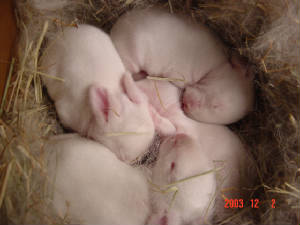
6 Day Old Kits
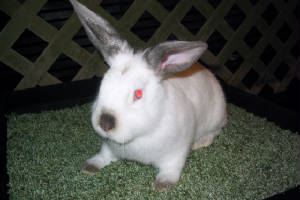
6 Week Old Kit
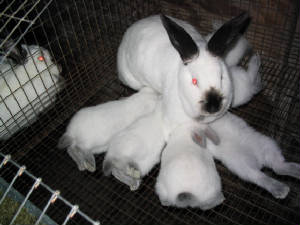
Doe Nursing Kits.
The nest box should be left in the cage for about three weeks, longer in the winter months if needed for warmth, shorter
in summer if it is real hot. Also if it is real hot after the kits get their fur start removing some of the hay little by
little so they can get air.Once the litter is born hopefully in the nest box, remove any afterbirth left behind and discard
and hay with blood on it to keep ants from being attracted to the smell. Check the box daily for any dead babies and remove
and bury or burn them to prevent disease. Any kits either born on the wire or that are still nursing when the Doe jumps out
of the box and brought kits out with her can sometimes seem cold and lifelessbut depending on how long it has been like this,
sometimes can be saved by emersing all but the head in a cup of Warm not hot water for a few minutes.
Miraculously after a few minutes it sometimes will start wiggling around. If so, a warm hair dryer to dry it and keep it warm.
But be careful not to overheat it and loose it to over heating after you have saved it. Just make sure you get it dry and
warm before returningvit to the nest box.
Once the kits start eating never let them run out of feed all the way up to show time and always dump
the old feed and put fresh feed daily.This is the most important time of growth for young kits. If keeping for replacemants
same applies except around 2 1/2 months start gradually cutting back the feed and then about 3 months feed
the normal amount you feed the senior rabbits except add about another 1/2 until about 6 months of age. This helps to
insure they reach their maxium growth potential.
|

